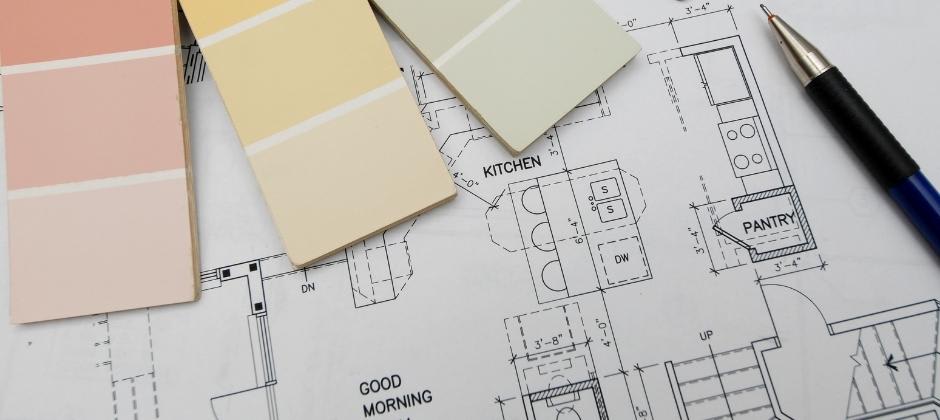Study Design: The Ultimate Student Guide (2024)
Have you considered studying a design degree abroad? Design is a huge global industry that will only grow further over time. Read our guide to discover why a design program could be the perfect fit for you!
- Subject Guides
- Design

SCHOLARSHIPS | STUDENT RESOURCES | MORE SUBJECT GUIDES
Have you considered studying a design degree abroad? If you’re inspired by the fashion houses of France, minimalist interiors of Scandinavian architecture, or Kpop concepts in South Korea, learn how to study design programs abroad using our guide.
Design is a huge global industry that will only grow further over time. Why? Well, for one, design is crucial for making products more efficient and more profitable. In addition, modern technological advancement has widened the scope of possibilities even further- the integration of technology into design seems almost limitless!
Do you have something special when it comes to integrating color, shape, technology, and function into the visual layout of objects or systems? Continue reading to discover why a degree in design might be an ideal path to follow.
In this guide:
- What is a design degree?
- Difference between art and design
- Areas of design you can study
- How long does a design degree take?
- Why study design abroad?
- Careers in design
- Salaries in the design sector
- Tips for choosing a design degree
- Advice from design graduates
- What to ask universities about their design programs
- What to look for in a university
- Design accreditations for universities
- Popular universities for studying design
Find a design degree in your dream destination
Find & compare design degrees from universities around the world!
What is a design degree?

Design is a word that encompasses a huge range of subjects, from interaction design to graphic design to textile design. At the very base of them all is a knack for imagining how an object or system can be made. So, design is essentially the act of planning and shaping ideas.
What's the difference between art and design?
Something that students often ask themselves when looking for a degree in design is: What's the difference between art and design? Aren’t they the same? Well, they actually are quite different.
The main difference to know is that art, whether that may be the Fine Arts or Performing Arts, is all about creativity and expression. In contrast, design integrates functionality and rational planning with creative vision. In short, design always has purpose while art may not. However, as with most things, these distinctions exist on a spectrum. Certain fields in design, like game, textile or user interface design, lean more towards the arts, while others such as interactive design and furniture design tend to be more technical in nature.
Which areas of design can you study?
If you’d like to study design programs abroad, one of the first things you’ll notice is that you have many options. In order to get further in your student journey, you’ll need to choose what kind of design you want to study.
If you’re interested in the ways in which humans communicate and interact:
Discover how humans interact with machines and other digital applications through sensor-based interaction and participatory design.
Focus on the creation and prototyping of modern service experiences and interactions, whether the systems are physical or virtual.
Develop your communication skills alongside your knowledge of visual design and use visual materials to best convey a message.
Design applied to computer graphics, visual displays, and media:
Create visual concepts like illustrations, graphics, and logos to promote products or ideas.
Discover graphic design, photography, and web design alongside marketing and communication in printed and digital media.
Learn to design and develop the creative and technical aspects of games and bring your artistic visions to life.
Learn how to design rooms, buildings, or products:
Get an education centered on the construction, design, and creation of unique and innovative pieces of furniture.
Learn about the unique aesthetics of interior spaces and understand the relationship between humans and spatial environments.
Become an expert in planning the architecture of lighting in indoor and outdoor environments.
Study how products, devices, objects, and services are designed and manufactured in modern markets.
Learn how to use the latest technologies to develop a product - from concept to design and production.
For those who love clothing and costumes:
Master the art of creating atmospheres in film, theater, and other visual industries through costume.
Explore the digital and artisanal production of textiles.
How long does it take to get a design degree?
A design diploma or certificate may be ideal if you want to dip your toes in the water. This would allow you to learn the fundamentals of design and try out different specializations while getting practical experience- perfect for students who want to explore a bit.
Studying a bachelor’s degree in design usually takes around three or four years. At the bachelor’s level, students are introduced to the fundamentals of their major. This means that you’ll get a balanced education starting with more general theory followed by practical knowledge of design. You’ll graduate with the skills you need to create an impressive portfolio of work, as a bachelor’s degree in design usually concludes with a big project or thesis.
A design degree at the master’s level takes around one or two years. This degree type is perfect for students who want more advanced skills, as master’s degrees are usually focused on a specialization such as Special Effects, Game Design, or UX Design. A master’s degree in design also prepares students for leadership positions. So, if you envision yourself as a manager of other designers in the future, put a master’s degree in design in the cards.
Why study design abroad?
At the core foundation of any design program is a dependence on functionality, but creative and visual aspects will depend on you, the designer. Here are some reasons why studying a design degree abroad might give you the edge you're looking for.
1. Seek inspiration and personal development
Creativity is a huge component of design and is something that can be individually developed through exposure to new things. You’ll not only have a new environment, culture, and language to take in, but also a new lifestyle to explore. Studying abroad will influence your personal style and artistic outlook by giving you creative inspiration and fresh perspectives.
2. Build a unique portfolio
Of course, you will also start working on your personal portfolio while studying a degree in design. The projects you work on during your courses are symbols of competency and skill for your future employer. Every project, internship, and job that you’re a part of while studying design abroad will give your portfolio a unique tone. With all this considered, you’ll surely stand out from the crowd when you’re applying for jobs.
3. Create a global network
Design is an industry that flows across global borders, as evidenced by the huge number of countries represented in the most popular design schools in the world. Naturally, your connections should also reach into global spaces.
The people you meet, including your fellow students and professors, are lifelong contacts that have the potential to launch you into an exciting, international career path. Alongside your new global network, your international experience and fluency in cross-cultural communication will show employers that you’re ready to take on a challenge.
4. Stand out from your competition
Getting a design degree abroad can make it easier for you to find a design job after you've graduated. By going beyond your home country's borders, you open yourself to opportunities for studying at universities in some of the world's biggest design centers, such as the United States, United Kingdom, Italy, Denmark, The Netherlands and Hong Kong.
Employers know the value of an internationally recognized degree, and the effort it takes to acquire one. While your portfolio is the most important factor, when it comes to making the decision to hire you, studying at a world-renowned university will both improve your design skills and make your resume stand out from the rest.
Careers in design
Looking for a career that values creativity, innovation, and functionality? There's a large amount of freedom to explore your options and grow in the areas you're most interested in. Here are some potential design jobs:
• Art director
• Advertising manager
• Ergonomist
• Interior designer
• Graphic designer
• Multimedia artist
• Sound engineer
• UX designer
• Video game designer
• Web designer
Within the creative field, international students can study anything from ergonomics to UI design. As such, career directions are as varying as the options within the field of studying design programs.
What are salaries for graduates of a design degree?
Expected salaries for careers stemming from a degree in design vary widely. We’ll provide some expected salaries of a few of the most popular career choices and the average salary for bachelor’s and master’s degree.
Graphic design graduates 🎨
| UK (GBP) | BA: £26k/year | MA: £28k/year | ||
| USA (USD) | BA: $48k/year | MA: $67k/year | ||
| Germany (EUR) | BA: €45k/year | MFA: €45k/year | ||
| Australia (AUD) | BA: $52k/year | MA: $61K/year |
Product design graduates📱
| UK (GBP) | BA: £26k/year | MA: £26k/year | ||
| USA (USD) | BA: $83k/year | MS: $90k/year | ||
| Germany (EUR) | BA: €46k/year | MS: €48k/year | ||
| Australia (AUD) | BA: $56k/year | MA: $77k/year |
Industrial design graduates 🏙️
| UK (GBP) | BID: £32k/year | MEng: £34k/year | ||
| USA (USD) | BID: $70k/year | MS: $84k/year | ||
| Germany (EUR) | BDes: €54k/year | MDes: €57k/year | ||
| Canada (CAD) | BID: $59k/year | MDes: $77k/year |
Game design graduates 🎮
| UK (GBP) | BA: £23k/year | MA: £26k/year | ||
| USA (USD) | BA: $49k/year | MA: $80k/year | ||
| Germany (EUR) | BA: €42k/year | MA: €77k/year | ||
| Canada (CAD) | BA: $50k/year | MCS: $71k/year |
Tips for choosing a design degree
When deciding which design degree to apply for, first try to answer the following questions:
- How much time and money can I devote to a program?
- Do I need to travel or relocate to study a program?
- What skills do I hope to gain from a program?
- What kind of certification or degree do I want to receive?
- How will a university degree help me compared to the self-taught route?
- Does this program include a mandatory internship?
- Can I afford the cost of required design tools (software and devices) if the university doesn't provide them?
- Does the university offer yearly galleries and other student-led activities?
- Do the program professors actually work in the industry, or do they only teach?
It’s important to do some self-reflection on your own goals and priorities before you start looking for a program. Once you have a better idea of what kind of program to study and where, you’ll be able to choose a degree more easily, whether that be an online program, an undergraduate abroad, or a graduate program at home. If you want to join the growing number of international students who study design programs abroad, you can find more country-specific study abroad information in our country guides.
A bachelor’s degree in design will be less specialized than a master’s degree in design, but that doesn’t mean you can’t specialize in a particular area. Check out our degree guides to learn more about the requirements and benefits of different degrees, and consider your career goals in the process. Hunt down some job ads that sound interesting and match different programs to what your dream job may require.
Make sure that you know with certainty that you want to study design at a university. Analyze the value it would bring you over going the self-taught or short program route, as the programs can get quite expensive over time. Unlike most programs, the costs of studying design not only include tuition, but also the materials to do the work, such as powerful laptops and computers, possibly iPads or other drawing tablets, expensive software, and art supplies depending on the program (canvases, paint, charcoal, oil paint, etc.).
Helpful advice from degree graduates
We talked with some graduate students who had recently completed their programs in design or are currently undertaking it to see what they thought about their program and if they have any advice to share with you.

"My favorite part about studying design was getting to experiment with different media and learning how to use them in tandem to tell a richer story. My advice to prospective students is to keep trying out new design fields and ways of approaching problems. Discover what form of design feels the best for you. If you truly love your work, the skills will follow."
- Sara Evans, Bachelor’s degree in Design from Univerzitet Metropolitan
What questions should you ask a university to find the right design program?
We also asked the same students above if there were any questions they asked or wished they had asked during the research and application process to determine which program was right for them. Here were the most common and helpful questions they think you should be asking universities before you apply.
- Is the program specialized in a certain area of the design?
- What design software will I learn how to use in this program?
- Are there opportunities to have an internship or get work experience as part of the program?
- Do you have any established partnerships with companies when it comes to internships and jobs after graduation, or will I have to find an internship myself?
- What job positions do your graduates typically end up taking?
- Does your university actively share job and design competition opportunities with students?
- How big are the cohorts for each program?
What should I look for in a university for studying design?

The best design programs combine theory with practice. Courses with individual projects are ideal so that you have something tangible to showcase your skills when you graduate.
Courses that teach you hard skills
While soft skills are certainly important, pursuing a degree that includes hard skills as part of its curriculum is crucial for job-hunting post-graduation. Some tools are universal to all design programs because they're the industry standards, such as Adobe Photoshop, Adobe Illustrator, and After Effects. However, there are many others, and which ones you'll be learning will largely depend on your field or major. Here are a few examples:
- Graphic Design: Adobe InDesign (document layouts), Sketch (MacOS)
- Media Design: Adobe Premiere Pro (video editing), Adobe After Effects (video effects and animation), Autodesk Maya and Blender (3D modeling and animation)
- Game Design: Unity (game engine), Autodesk Maya, Blender
- Product Design: Adobe XD and Figma (prototyping), Sketch
Connections in the design industry
It’s also important to choose a university with links to areas of the design industry you’re interested in. Look for any workshops with companies and agencies that schools offer, and check out internship programs and alumni of the program. Universities sometimes share their graduates' success stories on their website, but you can also join public student forums or Facebook groups related to that university or program, and ask questions there.
Design jobs are competitive, so students from universities with established company partnerships or larger industry networks tend to have an easier time finding a job after graduation.
Specialization
Finally, a program that can specialize in a specific area of design is ideal. Design is an umbrella term for many different degrees and skills. While it is great to become a jack of all trades, honing your skills in a very specific sub-field or the ability to personalize your course selection is going to help you out in the long-run.
Some design programs are specialized by nature, like those in game or fashion design. Others allow you to narrow down your specialization after a year or two of general design and visual art courses. For example, learning general graphic design for two years and then specializing in packaging design for the rest of the design program.
Alternatively, you can take a look at dual degree programs or options to add on a minor to boost your portfolio even further. For example, a dual degree in web design and computer science might give you exactly what you need.
Types of accreditation for design degrees
It’s crucial to verify that a school is accredited before you apply. Accreditation ensures the highest quality of education, makes it easier to determine the value of college credits, allows students to apply for federal loans or grants, is considered by potential employers, and pushes schools to continually improve.
Students interested in the design industry should look for regional, national, or program-specific accreditations, such as the following:
NASAD Certification
The National Association of Schools of Art & Design (NASAD) awards 350 academic institutions in the United States with accreditation. NASAD accredits a variety of design programs along with different art programs. If you are thinking about studying design or art in the Untied States, institutions that are certified by NASAD are a good bet!
ECIA Certification
If you want to study interior design in Europe, look out for the European Council of Interior Architects (ECIA). ECIA accredits 16 national organizations of education in interior design.
You should be able to find information about accreditation on the website of any design program. Ensure that the program or institutional credibility of the school is there so that employers take your degree seriously!
Popular universities to study design
Istituto Europeo di Design (IED)
Location: Italy, Spain, and Brazil
Courses available in: Interior Design, Media Design, Product Design, Textile Design, and more.
Accademia del Lusso School of Fashion & Design
Location: Milan, Italy
Courses available in: Interior Design, Fashion Design, Accessory Design
The new school
Location: New York, United States
Courses available in: Communication Design, Fashion Design
Marbella Design Academy
Location: Marbella, Spain
Courses available in: Interior Design, Graphic Design, Fashion Design, Media Design
Ready to study design abroad?
Find & compare design degrees from universities around the world.

Author
The Keystone Team is comprised of experienced educators and advisors dedicated to providing valuable resources and advice to students all over the world.
Read related articles

Study Psychology: The Ultimate Student Guide (2024)

Study Political Science: The Ultimate Student Guide (2024)
